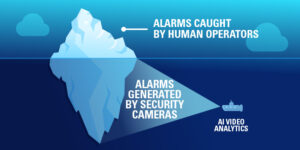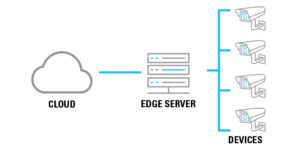When looking at the latest CCTV technology, 2022 brought a new wave of remote-first, scalable solutions. Key video security trends gaining momentum include cloud-native solutions, AI-powered video analytics, and a move away from analog to 100% digital video systems.
Focusing on business security, camera trends include leveraging footage into valuable data with the help of AI, and investing in “As a Service” (AaS) solutions for scalable ways of introducing new technologies into existing operations and standards, from on-premise security systems to ONVIF camera compliance.
Below are the latest CCTV camera technology trends in more detail. Find out how to best integrate these security camera industry trends into your security system.
AI video analytics technology is transforming footage into big data
Thanks to AI, it is possible to turn hours of previously redundant footage into data, which can then be analyzed for video security trends and patterns. Whereas before, security teams only learned from the incidents identified manually, now they can learn even more from hours of untapped video that were previously skipped over.
One of 2022’s most significant commercial security camera trends is leveraging video analytics technology to generate big data. Below are some of the factors driving its growth.
Deep learning helps security teams make better, faster decisions
The growth of deep learning in video security is one of the latest CCTV technology trends. Video analytics is a prime example of cutting-edge technology being adopted by mainstream manufacturers and distributors across the commercial security camera industry.
AI vision solutions, or “computer vision” as it is known in the machine learning field, uses a highly sophisticated type of artificial intelligence known as convolutional neural networks. These networks analyze images, looking for patterns that correspond to generalized concepts such as people or vehicles. The more examples a network is given, the better it becomes at identifying these concepts quickly and accurately – which means this technology is set to become even more advanced in the near future.
So why are video analytics such a game-changer for security teams? Enhancing video security with analytics enables teams to do much more with the resources they already have. Over an average shift, a security professional’s accuracy when monitoring video decreases due to tiredness and distractions, whereas video analytics can accurately monitor video 24/7/365. Analytics also remain consistently fast at processing video.
These video security trends do not mean that security professionals are about to be replaced by algorithms. AI is only as good as the people directing it, so security professionals still need to verify alarms to make sure they are handled appropriately.
Adopting video analytics into the latest CCTV camera technology makes a video security operator’s job easier by automating the time-intensive, low-output tasks like watching hours upon hours of video. Now, teams can work smarter with the extra time and energy they have. With analytics providing fast, consistent intelligence, teams are better able to make split-second decisions about how best to respond to incidents.




